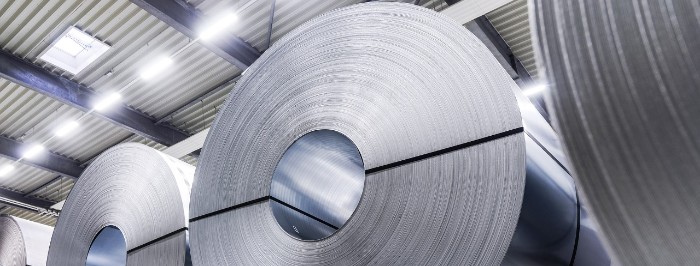FAQS & GLOSSARY
Here you will find answers to the most frequently asked questions about Green Steel and sustainability, as well as brief explanations of the most important terms.
FAQs
Right now, there is no universal definition of green steel. It is often used as an umbrella term to describe any steel with reduced carbon emissions during production. We think only steel with the lowest possible carbon emissions should be called “green.” meaning steel produced using direct reduced iron + green hydrogen or an electric arc furnace + 100% scrap and renewable electricity to eliminate emissions as far as possible. Other steel with lower emissions is “carbon reduced.”
Green steel from scrap and other carbon-reduced steel products are available today – especially for long steel. Green steel from green hydrogen is at the pilot stage. Commercial uptake is expected in 2024/25. Scaling up volumes will take time, as this requires a) established steel producers to change their production processes or b) new entrants using new technologies (such as H2 Green Steel) to reach industrial production size.
Right now, there is no single label or certification that allows a customer to claim that they are purchasing green steel. Some steel producers are starting to have their products certified as green, but these certifications differ and are hard to compare. We want to make this easier for customers, so we have developed a universal standard and label.
We are looking to help customers in three ways: 1. We help them gain a better understanding of the changing steel landscape and what this means for their organization. 2. We will enhance transparency for them by tracking emissions for our steel products including the entire supply chain. 3. Thanks to our long-term partnerships, we secure reliable volumes of hard-to-source green steel and other carbon-reduced steel products for them even in times of scarcity.
How much green steel will save in terms of emissions depends on the starting point. Presuming an average ton of flat steel from a blast furnace as the starting point, green steel can reduce Scope 1 and 2 emissions by up to ~95%. Carbon-reduced steel from an electric arc furnace achieves a 45% reduction, while scrap-based EAF steel reduces emissions by ~75%.
In the future, green steel and other carbon-reduced steel products are likely to be attainable on spot markets. For the former, this will take years as production is scaling up and planned volumes are being pre-purchased today. For both varieties, it will be tricky in the beginning to ensure that you are actually getting what you want.
We are working with our suppliers to provide transparency on the emission intensity of our carbon reduced steel products. We will validate this information and pass it on to our customers. We will disclose all emissions data from cradle to gate.
Avoiding and reducing emissions is a top priority for us. We have set ambitious SBTi*-certified reduction targets and are actually carbon neutral ourselves today. We use high-quality, certified compensation options to achieve this. Because as far as our planet is concerned, offsetting is not the same as actual emission reductions.
*Science Based Targets initiative, the leading certification of corporate decarbonization targets. It collaborates closely with the Carbon Disclosure Project and the GHG Protocol.
GLOSSARY
1.5° path |
Emission reduction path that leads to 1.5° Celsius global warming compared to pre-industrial levels - ambition of the Paris Agreement. |
|||||||
Abatement |
Combination of avoidance, reduction and removal. The term is used only in abatement curve. |
|||||||
Blast Furnace |
Blast Furnace is one of the two predominant production pathways for steel, especially in Europe and Asia. The emissions of the Blast Furnace are more than twice those of the Electric Arc Furnace. |
|||||||
Breakthrough technologies |
Technologies that produce low-carbon steel in a radically different way to the conventional Blast Furnace, DRI or EAF technology. |
|||||||
Climate Neutral / Net-Zero |
State when a company's activities have no net effect on the climate. This includes that residual GHG emissions that cannot be eliminated are removed from the atmosphere. Climate Neutral and Net-Zero are typically used interchangeably: Climate Neutral also takes into account regional or local bio-geophysical effects on the climate, however these do not exist for most companies.1 |
|||||||
Climate Positive |
State when a company's activities remove more GHG from the atmosphere than it emits. |
|||||||
Corporate Carbon Footprint (CCF) |
CO2-emissions of a company in a given year along the entire value chain. |
|||||||
Corporate Social Responsibility (CSR) |
Integration of social and environmental concerns in business operations of a company and its interactions with stakeholders. |
|||||||
Direct Reduced Iron |
Direct reduced iron is produced from iron ore via direct reduction. A gas or an elemental carbon usually serves as reductant. In the past, this has typically been natural gas or coal. In the future this might be Hydrogen. |
Electric Arc Furnace |
Electric Arc Furnace is one of the two predominant production pathways for steel. In the US it is even more common than the Blast Furnace route, which dominates in Europe and Asia. The emissions of the Electric Arc Furnace are around 45% less than those of the Blast Furnace. |
|||||||
Emissions |
Short term for greenhouse gas emissions. |
|||||||
Environmental/Social/Governance (ESG) |
Non-financial factors in a company's strategy and reporting, increasing focus of investors when evaluating company performance. |
|||||||
Greenhouse Gases (GHG) |
Greenhouse Gases include CO2, CH4, N2O, HCFs, PFCs, SF6, NF3.1 |
|||||||
Greenhouse Gas Protocol |
The GHG Protocol is the leading carbon accounting body and headed by the World Resources Institute. It closely collaborates with the Carbon Disclosure Project and the Science Based Target initiative. |
|||||||
Green Steel |
GHG are physically removed or sequestered from the atmosphere as a result of a specific intervention, e.g., carbon capture & storage, growing forests.1 |
|||||||
Greenwashing |
Refers to the act of making false or misleading claims about the environmental benefits of a product, service, technology, etc. |
|||||||
Hydrogen |
Through the use of new technologies, hydrogen is a key vector that will allow GHG emissions from the iron and steel sector to be significantly reduced. |
|||||||
Life-Cycle Assessment |
Assessment of the environmental impact of a product during its life cycle. |
|||||||
Offsetting (= Compensation = Neutralisation) |
Procurement of offsetting certificates for emission abatement elsewhere and use of these certificates to count against own carbon footprint. Offsetting cannot be deducted from the corporate carbon footprint but needs to be reported separately. It does not count towards physical CO2-reduction needed to comply with science-based targets.2 |
|||||||
Paris Agreement |
Legally binding international treaty signed in 2015 to limit global warming to well-below-two, preferably to 1.5 degrees Celsius, compared to pre-industrial levels. To achieve this, countries aim to make the world climate neutral by mid-century.3 |
|||||||
Product Carbon Footprint |
CO2-emissions of a product during its life cycle. |
Reduction |
Emissions to the atmosphere are reduced, i. e. a process or activity physically emits fewer or no greenhouse gases |
|||||||
Removal |
GHG are physically removed or sequestered from the atmosphere as a result of a specific intervention, e.g., carbon capture & storage, growing forests1 |
|||||||
SBTi |
Science Based Target initiative. The leading certification of corporate decarbonization targets. It closely collaborates with the Carbon Disclosure Project and the GHG Protocol. |
|||||||
Scope 1 |
Direct emissions from a company's own facilities and from company vehicles.2 |
|||||||
Scope 2 |
Indirect emissions from purchased electricity, steam, heating & cooling for own use.2 |
|||||||
Scope 3 Upstream |
Indirect emissions from supply chain (purchased goods and services, transportation and distribution, business travel, etc.). 2 |
|||||||
Scope 3 Downstream |
Indirect emissions from the use of the product (incl. distribution, end-of-life, etc.). 2 |
|||||||
Well-below-two degrees (WB2D/1.75°) path |
Emission reduction path that leads to well-below-two-degrees Celsius global warming compared to pre-industrial levels, as targeted in the Paris Agreement. |
|||||||
Zero Carbon Steel |
Steel that needs to be produced without any CO2 emissions at all. This is a very high bar to reach, and it is difficult to conceive of a production technology that could achieve this in the short-term. |
MORE INFORMATION
CONTACT US
Do you have any questions concerning sustainable steel or would you like to learn more about the topic? Then send us a message below and our experts will be happy to help you.
Thank you!
Our experts will get in touch with you.


